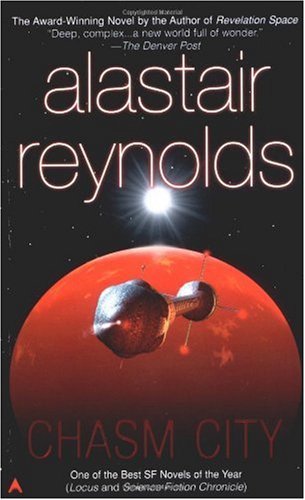Alastair Reynolds, Chasm City
reviewed by Danielle L. Parker

Chasm City Publisher: Ace, 2003 Length: 694 pages ISBN: 0-441-01064-4 |
Big in scope: good and evil, vast reaches of time and space, men and mutant pig-men and aliens from the void. Chasm City is like a bowl of wildly overflowing yeast. Even the author can’t punch it down to an entirely manageable shape.
We start out with two interleaving story lines. One seems to concern Tanner Mirabel, a mercenary soldier in the hire of an arms smuggler and warlord named Cahuella. He’s out for revenge on an aristocrat named Reivich, who, in revenge for Cahuella killing his family, caused the death of Cahuella’s wife, for whom Tanner had an unrequited passion. Soprano fans yawn in déjà vu here, but hey, however far in the future we go, there’s apparently still thuggery going on somewhere.
Of course, Tanner’s whole planet, Sky’s Edge, is in the grip of an incestuous civil war started before its flotilla of long-sleep colonists and multi-generational crew even arrived from Earth. Hence Cahuella’s booming arms trade and zest for fueling the flames.
In the process of chasing Reivich, who’s fled off-world, Tanner appears to be infected by a mysterious virus spread by a cult religious group. The group worships (although they also killed) the colony ship’s captain (and instigator of the unending civil war), Sky Haussmann.
Tanner, caught in an accident that lands him, fifteen years of long-sleep later, in Chasm City, begins to have disturbing hallucinations of Sky’s life, from childhood on up.
But the virus-inspired visions don’t follow the sanitized mythos. Sky seems to be a bad man, who did some really bad things, including torture, murder, and good old scheming for the top job.
Only, why do hallucinations of a man who lived centuries before start to seem to Tanner like... memory? And why does Tanner sometimes remember from the perspective of Cahuella, the arms dealer and big (really big) snake game hunter, rather than just his own viewpoint?
The book is a shell game of personality switches. Tanner may not be the person he thinks he is. He thinks he’s a good man, but he might not be. He thinks his boss Cahuella is a bad man, but he might not be. Reivich, the man he so ardently and vengefully pursues, might be a bad man... or he might not be.
Not many authors have the guts to write such an ambitious story. Reynolds kept me pinned to the next page to the end.
Though I’ll admit, that ending left me distinctly uneasy. Yes, there were a few logical inconsistencies, not a surprise in this huge a book. But that wasn’t the cause of my unease.
This story deals with good and evil: specifically, whether the multiple personalities in this epic are good or evil men. My uneasiness was due to the fact the main character ends up thinking he is a good man.
I was afraid maybe the author thought he was, too. But when you’re left wondering what the man behind the curtain really thinks, at least he stayed off the stage, as an author should.
For the main character in this story was a monster.
How banal evil always is, in the final weighing: less grand schemes and lofty ambition than I want his job or I want his money or I want his woman. Torture, not the glittering pinnacle of evil, but revenge for childish traumas.
But then, even Lucifer’s fall was banal. The Prince of Darkness just wanted to be a Real Big Somebody. He lusted after the job.
Still, I give Reynolds high marks for his big story, overall. Nice to meet a writer with lofty ambitions, at least. Enjoy!
Copyright © 2010 by Danielle L. Parker

